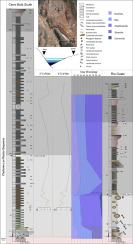当前位置:
X-MOL 学术
›
Gondwana Res.
›
论文详情
Our official English website, www.x-mol.net, welcomes your
feedback! (Note: you will need to create a separate account there.)
Evidence for the Carnian Pluvial Episode in Gondwana: New multiproxy climate records and their bearing on early dinosaur diversification
Gondwana Research ( IF 7.2 ) Pub Date : 2020-10-01 , DOI: 10.1016/j.gr.2020.05.009 Adriana C. Mancuso , Cecilia A. Benavente , Randall B. Irmis , Roland Mundil
Gondwana Research ( IF 7.2 ) Pub Date : 2020-10-01 , DOI: 10.1016/j.gr.2020.05.009 Adriana C. Mancuso , Cecilia A. Benavente , Randall B. Irmis , Roland Mundil

|
Abstract The Triassic hothouse world experienced dynamic changes in climate and ecosystems that set the Earth's climate and biotic states for much of the Mesozoic Era. A critical time interval was the Carnian Stage (~237–227 Ma), which not only saw the first appearance of dinosaurs in the fossil record but witnessed a large igneous province eruption (Wrangellia LIP) and a sudden climate shift, the Carnian Pluvial Episode (CPE). Compelling hypotheses suggest that the Wrangellia eruptions caused the CPE, which in turn set the stage for the origin and initial diversification of dinosaurs. Unfortunately, testing these hypotheses is difficult because most relevant Carnian sedimentary archives possess few if any absolute age constraints, and there are little detailed paleoclimatic data for the CPE outside of the Tethys region. There is little existing evidence for the CPE in Gondwana, even though this region contains by far the best fossil record of early dinosaurs and their close relatives. We present new high-resolution geochronologic and paleoclimatic data from Carnian-aged strata in the Ischigualasto-Villa Union Basin of northwest Argentina, which also preserves fossils of the earliest-known dinosaurs. New CA-TIMS U Pb zircon age of 234.47 ± 0.44 Ma from the lower Los Rastros Formation demonstrates that most of the overlying lacustrine strata within this basin was deposited during or after the CPE, including large dinosauriform footprints. Multiproxy paleoenvironmental data (sedimentology, clay mineralogy, C and O stable isotopes, and fossils) from the same strata are the first detailed paleoclimate data for the CPE in Gondwana, and provide evidence that the CPE interval in western Gondwana was indeed warmer and more humid than before or after. These data are consistent with the interpretation of the CPE as a global event, but direct linkages in Gondwana and the Tethys with the origin and initial diversification of dinosaurs are less clear.
中文翻译:

冈瓦纳大陆卡尼期雨季的证据:新的多代理气候记录及其对早期恐龙多样化的影响
摘要 三叠纪温室世界经历了气候和生态系统的动态变化,这些变化决定了中生代大部分时间的地球气候和生物状态。一个关键的时间间隔是卡尼阶(约 237-227 Ma),它不仅在化石记录中首次出现恐龙,而且目睹了大规模的火成岩省喷发(Wrangellia LIP)和突然的气候变化,即卡尼阶雨季(CPE)。令人信服的假设表明,兰格利亚火山喷发导致了 CPE,这反过来又为恐龙的起源和最初的多样化奠定了基础。不幸的是,验证这些假设很困难,因为大多数相关的卡尼阶沉积档案几乎没有绝对的年龄限制,而且在特提斯地区以外的 CPE 几乎没有详细的古气候数据。冈瓦纳大陆的 CPE 几乎没有现有证据,尽管该地区包含迄今为止最好的早期恐龙及其近亲化石记录。我们提供了来自阿根廷西北部 Ischigualasto-Villa Union Basin 的 Carnian 时代地层的新的高分辨率地质年代学和古气候数据,该地层还保存了已知最早的恐龙化石。来自Los Rastros 组下部的新CA-TIMS U Pb 锆石年龄为234.47 ± 0.44 Ma,表明该盆地内的大部分上覆湖相地层是在CPE 期间或之后沉积的,包括大型恐龙脚印。来自同一地层的多代理古环境数据(沉积学、粘土矿物学、C 和 O 稳定同位素以及化石)是冈瓦纳大陆 CPE 的第一个详细古气候数据,并提供证据表明冈瓦纳西部的 CPE 间隔确实比之前或之后更温暖、更潮湿。这些数据与将 CPE 解释为全球事件的解释一致,但冈瓦纳和特提斯与恐龙起源和最初多样化的直接联系尚不清楚。
更新日期:2020-10-01
中文翻译:

冈瓦纳大陆卡尼期雨季的证据:新的多代理气候记录及其对早期恐龙多样化的影响
摘要 三叠纪温室世界经历了气候和生态系统的动态变化,这些变化决定了中生代大部分时间的地球气候和生物状态。一个关键的时间间隔是卡尼阶(约 237-227 Ma),它不仅在化石记录中首次出现恐龙,而且目睹了大规模的火成岩省喷发(Wrangellia LIP)和突然的气候变化,即卡尼阶雨季(CPE)。令人信服的假设表明,兰格利亚火山喷发导致了 CPE,这反过来又为恐龙的起源和最初的多样化奠定了基础。不幸的是,验证这些假设很困难,因为大多数相关的卡尼阶沉积档案几乎没有绝对的年龄限制,而且在特提斯地区以外的 CPE 几乎没有详细的古气候数据。冈瓦纳大陆的 CPE 几乎没有现有证据,尽管该地区包含迄今为止最好的早期恐龙及其近亲化石记录。我们提供了来自阿根廷西北部 Ischigualasto-Villa Union Basin 的 Carnian 时代地层的新的高分辨率地质年代学和古气候数据,该地层还保存了已知最早的恐龙化石。来自Los Rastros 组下部的新CA-TIMS U Pb 锆石年龄为234.47 ± 0.44 Ma,表明该盆地内的大部分上覆湖相地层是在CPE 期间或之后沉积的,包括大型恐龙脚印。来自同一地层的多代理古环境数据(沉积学、粘土矿物学、C 和 O 稳定同位素以及化石)是冈瓦纳大陆 CPE 的第一个详细古气候数据,并提供证据表明冈瓦纳西部的 CPE 间隔确实比之前或之后更温暖、更潮湿。这些数据与将 CPE 解释为全球事件的解释一致,但冈瓦纳和特提斯与恐龙起源和最初多样化的直接联系尚不清楚。










































 京公网安备 11010802027423号
京公网安备 11010802027423号